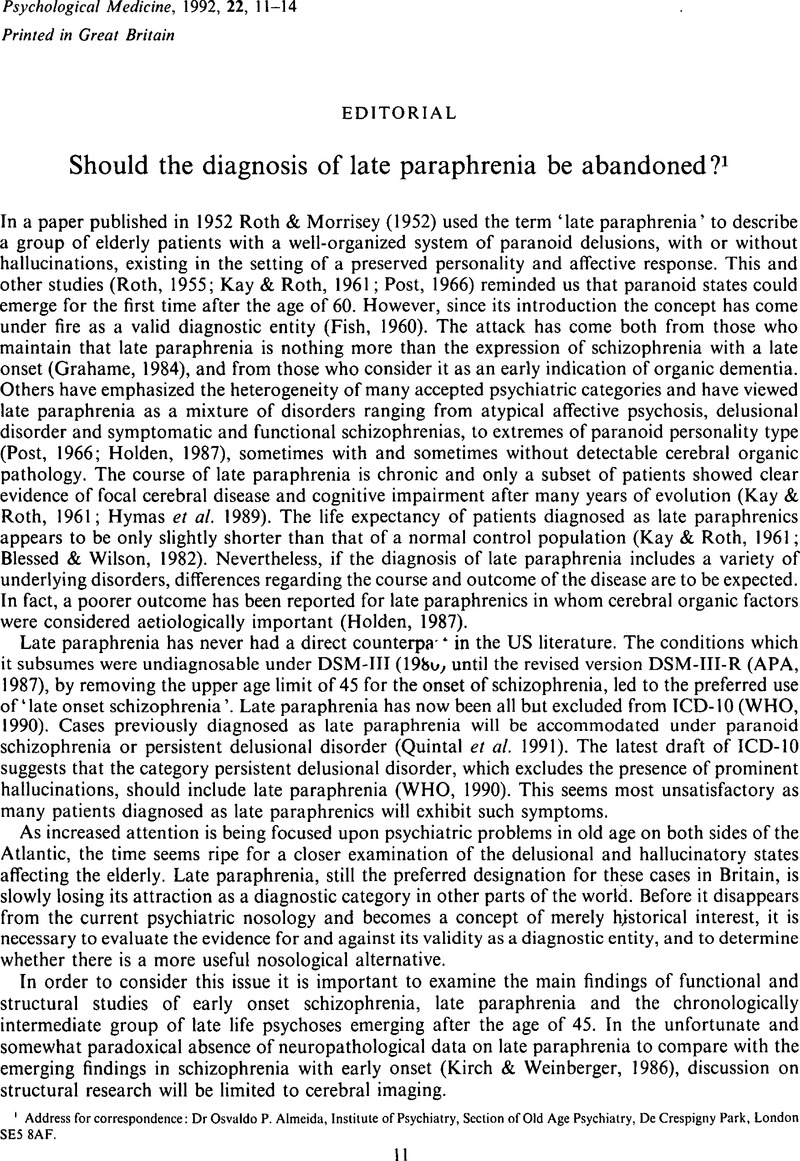Crossref Citations
This article has been cited by the following publications. This list is generated based on data provided by Crossref.
Almeida, Osvaldo P.
Howard, Robert
Förstl, Hans
and
Levy, Raymond
1992.
Late paraphrenia: A review.
International Journal of Geriatric Psychiatry,
Vol. 7,
Issue. 8,
p.
543.
Howard, Robert
Castle, David
O'Brien, John
Almeida, Osvaldo
and
Levy, Raymond
1992.
Permeable walls, floors, ceilings and doors. Partition delusions in late paraphrenia.
International Journal of Geriatric Psychiatry,
Vol. 7,
Issue. 10,
p.
719.
Ball, Christopher J.
1992.
The use of clozapine in older people.
International Journal of Geriatric Psychiatry,
Vol. 7,
Issue. 9,
p.
689.
Förstl, Hans
1993.
Author's reply.
British Journal of Psychiatry,
Vol. 163,
Issue. 5,
p.
694.
Charlesworth, Georgina M.
Hymas, Nigel
Wischik, Claude M.
Hodges, John R.
and
Sahakian, Barbara J.
1993.
Late paraphrenia, advanced schizophrenic deterioration and dementia.
International Journal of Geriatric Psychiatry,
Vol. 8,
Issue. 9,
p.
765.
Howard, Robert
Almeida, Osvaldo
and
Levy, Raymond
1994.
Phenomenology, demography and diagnosis in late paraphrenia.
Psychological Medicine,
Vol. 24,
Issue. 2,
p.
397.
Howard, Robert J.
Almeida, Osvaldo
Levy, Raymond
Graves, Phillipa
and
Graves, Martin
1994.
Quantitative Magnetic Resonance Imaging Volumetry Distinguishes Delusional Disorder from Late-Onset Schizophrenia.
British Journal of Psychiatry,
Vol. 165,
Issue. 4,
p.
474.
Addonizio, Gerard C.
1995.
Late Paraphrenia.
Psychiatric Clinics of North America,
Vol. 18,
Issue. 2,
p.
335.
Howard, R.
Mellers, J.
Petty, R.
Bonner, D.
Menon, R.
Almeida, O.
Graves, M.
Renshaw, C.
and
Levy, R.
1995.
Magnetic resonance imaging volumetric measurements of the superior temporal gyrus, hippocampus, parahippocampal gyrus, frontal and temporal lobes in late paraphrenia.
Psychological Medicine,
Vol. 25,
Issue. 3,
p.
495.
Almeida, O. P.
Howard, R. J.
Levy, R.
David, A. S.
Morris, R. G.
and
Sahakian, B. J.
1995.
Cognitive features of psychotic states arising in late life (late paraphrenia).
Psychological Medicine,
Vol. 25,
Issue. 4,
p.
685.
Almeida, Osvaldo P.
Howard, Robert J.
Levy, Raymond
and
David, Anthony S.
1995.
Psychotic States Arising in Late Life (Late Paraphrenia).
British Journal of Psychiatry,
Vol. 166,
Issue. 2,
p.
215.
van Os, J.
Howard, R.
Takei, N.
and
Murray, R.
1995.
Increasing age is a risk factor for psychosis in the elderly.
Social Psychiatry and Psychiatric Epidemiology,
Vol. 30,
Issue. 4,
p.
161.
Almeida, Osvaldo P.
Levy, Raymond
Howard, Robert J.
and
David, Anthony S.
1996.
Insight and paranoid disorders in late life (late paraphenia).
International Journal of Geriatric Psychiatry,
Vol. 11,
Issue. 7,
p.
653.
Almeida, Osvaldo P.
1998.
Early- vs. Late-Onset Schizophrenia.
American Journal of Geriatric Psychiatry,
Vol. 6,
Issue. 4,
p.
345.
Almeida, Osvaldo P.
1998.
Early- vs. Late-Onset Schizophrenia: Is It Time to Define the Difference?.
The American Journal of Geriatric Psychiatry,
Vol. 6,
Issue. 4,
p.
345.
Barclay, Lee
and
Almeida, Osvaldo P.
2000.
Schizophrenia in later life.
Current Opinion in Psychiatry,
Vol. 13,
Issue. 4,
p.
423.
Kingdon, David
Swelam, Maged
and
Granholm, Eric
2008.
Handbook of Behavioral and Cognitive Therapies with Older Adults.
p.
151.
Atkinson, Richard
Jolley, David
and
Burns, Alistair
2014.
Troublesome disguises.
p.
16.
Sugawara, Hiroko
Takamatsu, Junpei
Hashimoto, Mamoru
and
Ikeda, Manabu
2021.
Catatonia associated with late-life psychosis successfully treated with lithium: a case report.
Annals of General Psychiatry,
Vol. 20,
Issue. 1,



